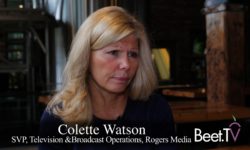TORONTO – When you’re the biggest wireless company in Canada, plus one of the biggest Internet service providers and cable companies, you know a lot about Canadians as content consumers. “For the last four years, we’ve done an enormous amount of work creating a massive data lake, compiling all of that data in one massive cube that enables us to slice and dice it in different ways,” says Alan Dark of Rogers Media.
“We’re very lucky here in Canada,” adds the company’s SVP of Media Sales. “We are a vertically integrated company.”
But even with the rights to National Hockey League games and its ownership of the Toronto Blue Jays baseball team, the clock is ticking at Rogers the same way it is at its Canadian competitors and the 50 states located below. While 85% to 90% of Canadian households subscribe to pay TV, that is slowly eroding.
In this interview with Beet.TV at the recent Future of Television Advertising Forum in Toronto, Dark says it will probably take the next three years to “flip” 50% of its approximately 2.4 million cable households to advanced TV options. In the meantime, data is opening new doors.
“What we’ve found is there’s a real opportunity to open up new products and services for both marketers and companies that are looking to make different types of business decisions based on the data we can provide them. Location being a massive opportunity,” Dark says in response to a question from interviewer Ashley J. Swartz, CEO and Founder of Furious Corp.
By marrying consumer data from cookies and set-top boxes “we can really start to define some really interesting audience segments and really understand the behaviors of these segments.”
Left behind will be contextual selling, to be replaced by “focus on a very niche audience, or as niche as a customer wants it to be, and approach marketing in a different way.”
A big step in this direction is the platform called Rogers Enabled Data (RED) that aggregates anonymous consumer data so companies can target specific audience segments. So someone watching Rogers GameCenter Live on an iPad will get “a very different set of messages throughout the game than what your neighbor is getting next door if he’s watching it on SportsNet, for instance,” says Dark.
It’s all part of Rogers’ race to stake its claim to the Internet of things on the connected-home front, a strategy has centerpiece is “really controlling the home from a full-pipe perspective.”
Amid all the change, Dark acknowledges the reality is that over-the-air television isn’t going away anytime soon.
“So we still want that mass reach. But if you can have specific messaging for a specific customer and we can find that customer within the ecosystem and serve them a different experience that is customized versus an OTA setup, I think there’s an enormous opportunity for us to capitalize on that.”
This video was recorded in Toronto at the Future of TV Advertising Forum. This Beet.TV series is sponsored by Finecast. For more segments from Toronto, please visit this page.






































